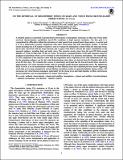Por favor, use este identificador para citar o enlazar a este item:
http://hdl.handle.net/10261/160769COMPARTIR / EXPORTAR:
 SHARE SHARE
 CORE
BASE CORE
BASE
|
|
| Visualizar otros formatos: MARC | Dublin Core | RDF | ORE | MODS | METS | DIDL | DATACITE | |

| Título: | On the retrieval of mesospheric winds on Mars and Venus from ground-based observations at 10 μm |
Autor: | López-Valverde, M. A. CSIC ORCID ; Montabone, Luca; Sornig, M.; Sonnabend, G. | Palabras clave: | Methods: observational Planets and satellites: atmospheres Planets and satellites: terrestrial planets Radiation mechanisms: non-thermal Radiative transfer |
Fecha de publicación: | 14-ene-2016 | Editor: | American Astronomical Society Institute of Physics Publishing |
Citación: | Astrophysical Journal 816(2): 103 (2016) | Resumen: | A detailed analysis is presented of ground-based observations of atmospheric emissions on Mars and Venus under non-local thermodynamic equilibrium (non-LTE) conditions at high spectral resolution. Our first goal is to comprehend the difficulties behind the derivation of wind speeds from ground-based observations. A second goal is to set a framework to permit comparisons with other observations and with atmospheric models. A forward model including non-LTE radiative transfer is used to evaluate the information content within the telescopic beam, and is later convolved with the beam function and a typical wind field to discern the major contributions to the measured radiance, including limb and nadir views. The emission mostly arises from the non-LTE limb around altitudes of 75 km on Mars and 110 km on Venus. We propose a parameterization of the limb emission using few geophysical parameters which can be extended to other hypothetical CO2 planetary atmospheres. The tropospheric or LTE component of the emission varies with the temperature and is important at low solar illumination but only for the emerging radiance, not for the wind determinations since these are derived from the Doppler shift at the non-LTE line cores. We evaluated the sources of uncertainty and found that the forward model errors amount to approximately 12% of the measured winds, which is normally smaller than the instrumental errors. We applied this study to revise a set of measurements extending for three Martian years and confirmed previous results suggesting winds that are too large simulated by current Martian circulation models at equatorial latitudes during solstice. We encourage new observational campaigns, particularly for the strong jet at mid-high latitudes on Mars, and propose general guidelines and recommendations for future observations. © 2016. The American Astronomical Society. All rights reserved. | Versión del editor: | https://dx.doi.org/10.3847/0004-637X/816/2/103 | URI: | http://hdl.handle.net/10261/160769 | DOI: | 10.3847/0004-637X/816/2/103 | ISSN: | 0004-637X | E-ISSN: | 1538-4357 |
| Aparece en las colecciones: | (IAA) Artículos |
Ficheros en este ítem:
| Fichero | Descripción | Tamaño | Formato | |
|---|---|---|---|---|
| IAA_2016_Lopez-Valverde_ApJ_816_103.pdf | 2,46 MB | Adobe PDF |  Visualizar/Abrir |
CORE Recommender
SCOPUSTM
Citations
5
checked on 18-abr-2024
WEB OF SCIENCETM
Citations
5
checked on 27-feb-2024
Page view(s)
304
checked on 24-abr-2024
Download(s)
248
checked on 24-abr-2024
Google ScholarTM
Check
Altmetric
Altmetric
NOTA: Los ítems de Digital.CSIC están protegidos por copyright, con todos los derechos reservados, a menos que se indique lo contrario.
